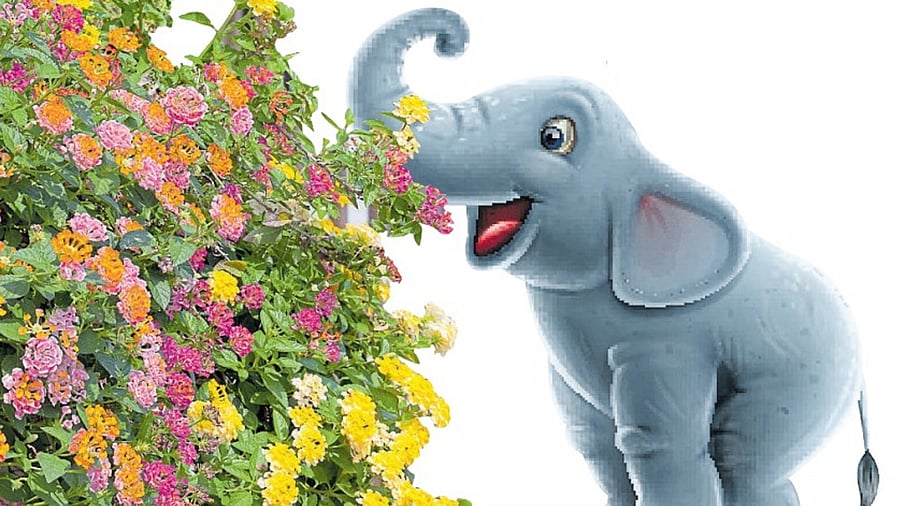
Image for representational purposes.
Credit: iStock
Elli, an Asian elephant, lived in the forests bordering Karnataka and Tamil Nadu. She loved exploring her forest. One day, during her usual family stroll, she saw a hint of beautiful colours amongst the green foliage.
“What is this beauty? I have never seen it before,” she thought. These were lantana shrubs. They were brought to India by the British as ornamental plants in the early 1800s. Its flowers seem to have captivated everyone who set their eyes on them. These shrubs had eventually made their way to Elli’s forest.
“Amma, Ajji, Akka, come look at these colourful shrubs — just like the rainbow,” said Elli excitedly. “Elli, look at them from afar. These are foreign shrubs. We don’t know much about them yet. So please be careful,” warned Ajji.
“Ok Ajji,” said Elli. Elli would look at her favourite shrubs lovingly everyday.
And not just Elli, but other native flora and fauna in the forest welcomed lantana shrubs with open arms. “Hi friends. Welcome to our humble abode,” said the native shrubs.
As time passed by, the lantana shrubs grew. Soon, Elli didn’t have to go far to see her colourful friends. They were everywhere.
“More colourful flowers. And you have friends too. Awesome,” said Elli.
“Peek a boo,” said Huli, the tiger. “You startled me, Huli. I have to say, these shrubs are great places to hide,” said Elli.
With time, the once loved lantana shrubs started showing their true colours.
“Hey, new shrubs! This is not fair. We welcomed you and you are preventing our growth. What is with these nasty chemicals that you are releasing? It makes us want to run away,” said the native shrubs, disappointed.
“Where did all our food go?” wondered Elli and her family. “Now we need to look elsewhere,” they thought. The fast growing and highly adaptable lantana was taking over the native flora. They were poisonous and inedible too. Soon enough the native flora and fauna understood that all that is colourful is not as pleasant as a rainbow.
Worried about their food, Elli and her family started going towards the villages. “Fruits, grains, grasses, and leaves. Easy and tasty food. Those nasty lantana are not here luckily,” they thought. They were wrong though.
Lantana had started wreaking havoc and were present everywhere. Possibly the village folk never saw it as a threat and had let them grow.
The villagers were not happy with elephants entering their farmlands. They loved elephants, but not at the cost of their crops and lives. “Why are elephants coming here? We need to protect our crops and ourselves from these elephants or send them away elsewhere,” they thought. The villagers also had many scary encounters with tigers, which they weren’t happy about. Human and animal conflicts increased by leaps and bounds.
There had to be a way to solve this problem and to restore peace. Scientists, forest departments, and locals, all joined hands to get rid of these shrubs. That seemed to be the only way out. But how to get rid of lantana shrubs? Hack them, spray chemicals, or another way? Uprooting the shrubs and planting something edible in its place seemed to be an answer. But what about all the cut lantana shrubs? What should be done with them? Burning, decomposing, or using them as fuel were some solutions.
But it was also important to spread awareness about lantana being a menace. Scientists and designers found a unique solution to this problem. What better way than to use lantana itself for this purpose? The sturdy and freely available lantana could be used to make furniture! And cool sculptures too.
And who was the inspiration behind the sculptures? Elli and her relatives. Their sculptures travelled all over the world. They were at airports, institutions, beaches, and at many other places! It was a win-win situation for everyone. Elli and family saw hope for their forest and for their food to be restored. Huli hoped to no longer have scary moments with villagers. The villagers were thankful that there would be lesser encounters with wildlife in the future and also for getting a new source of employment by making lantana crafts.
“Humans would have never known about our struggles and the dangers of lantana had we not paid them a visit in the first place,” said Elli. “Don’t forget the scariest hide and seek those humans got to play with me,” added Huli.
“Hadn’t I warned you about these foreign shrubs?” said Ajji. “Absolutely Huli. And Ajji, yes you were right. Bringing foreign plants and animals, however pretty they might be, comes with risks. Some are not as harmful as others though. But we couldn’t take matter into our own trunks and feet by pulling the shrubs out or by trampling them. We had to work as a team with humans. And now we have become international stars,” added Elli.
“Yes dear. Some humans do like to help us. But we have to be cautious. And by the way, we were stars to begin with,” said Ajji.